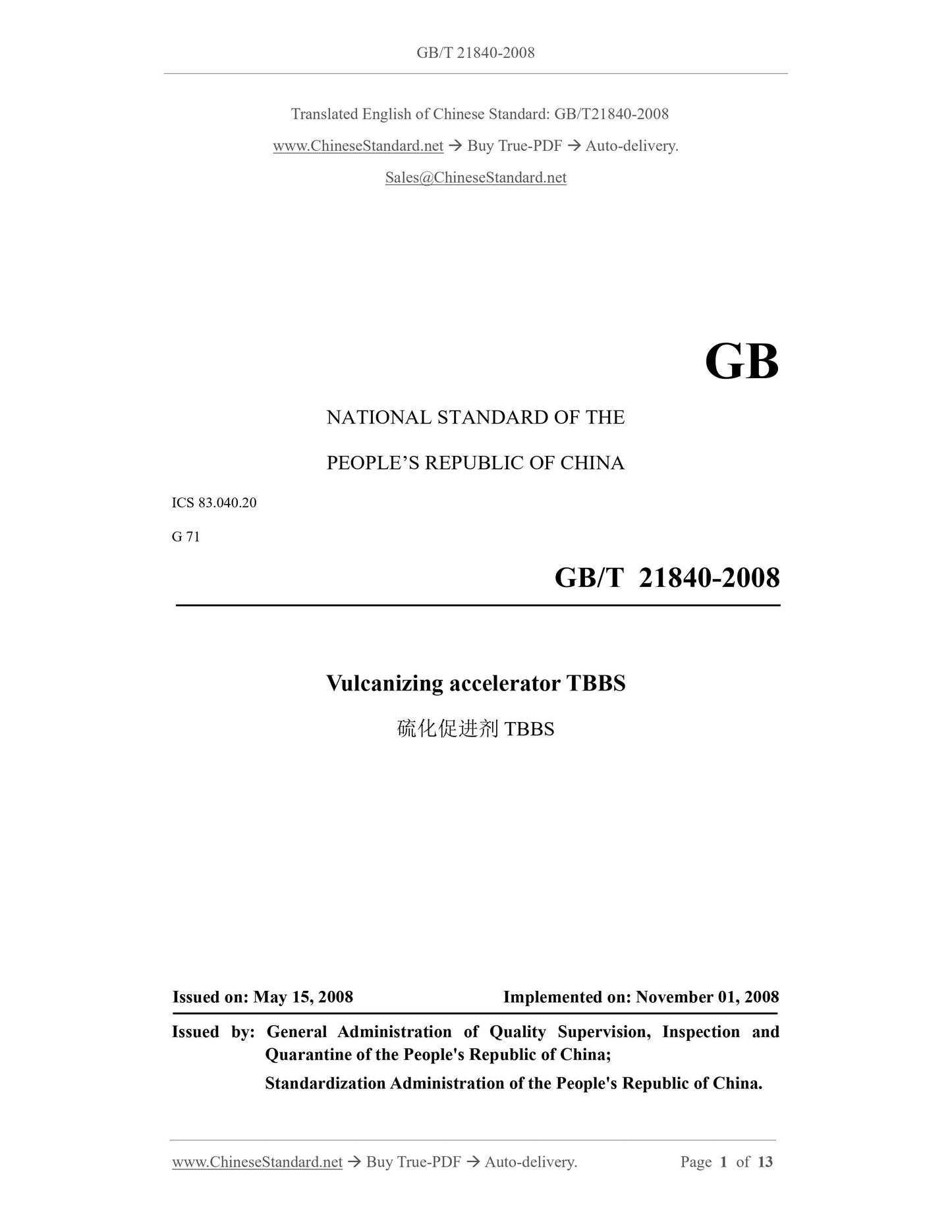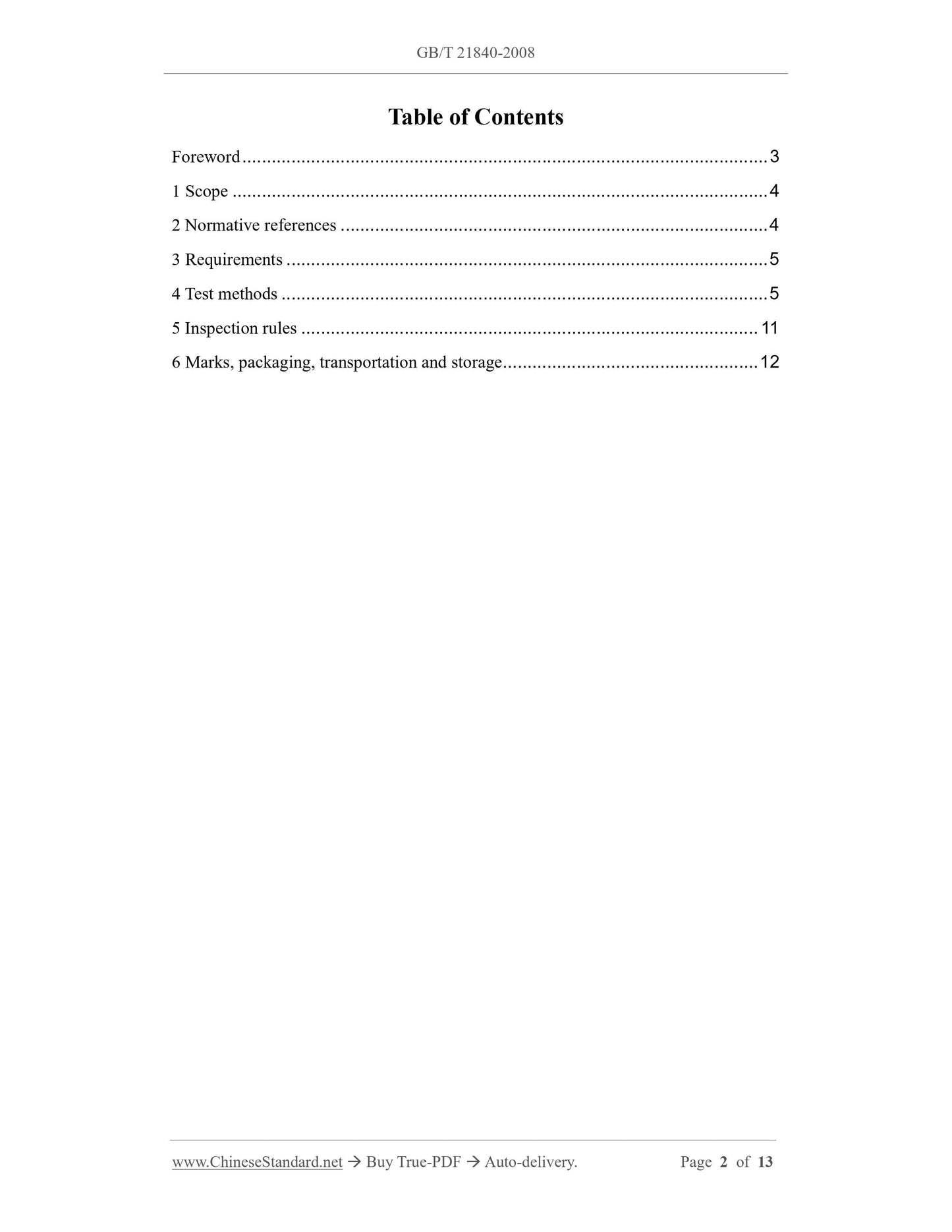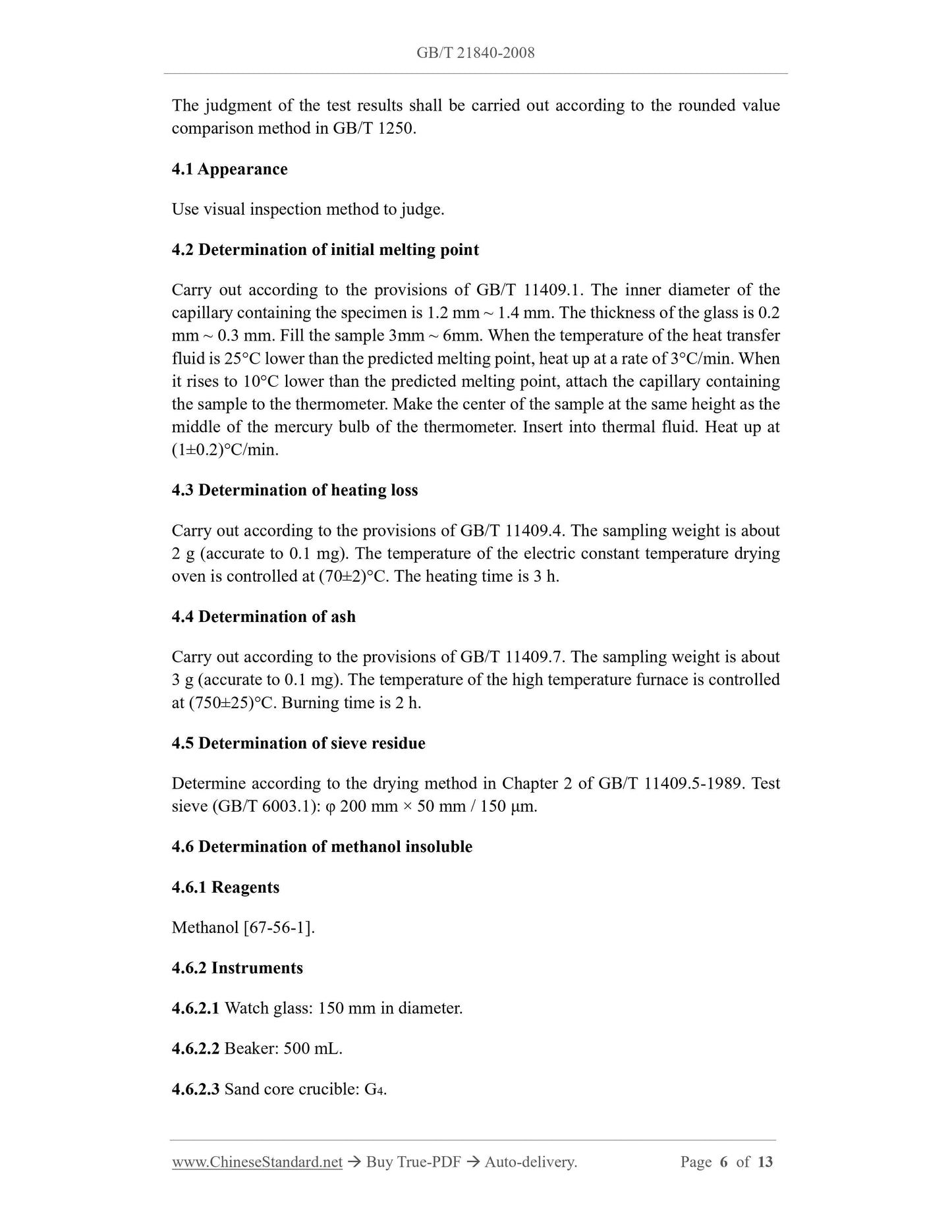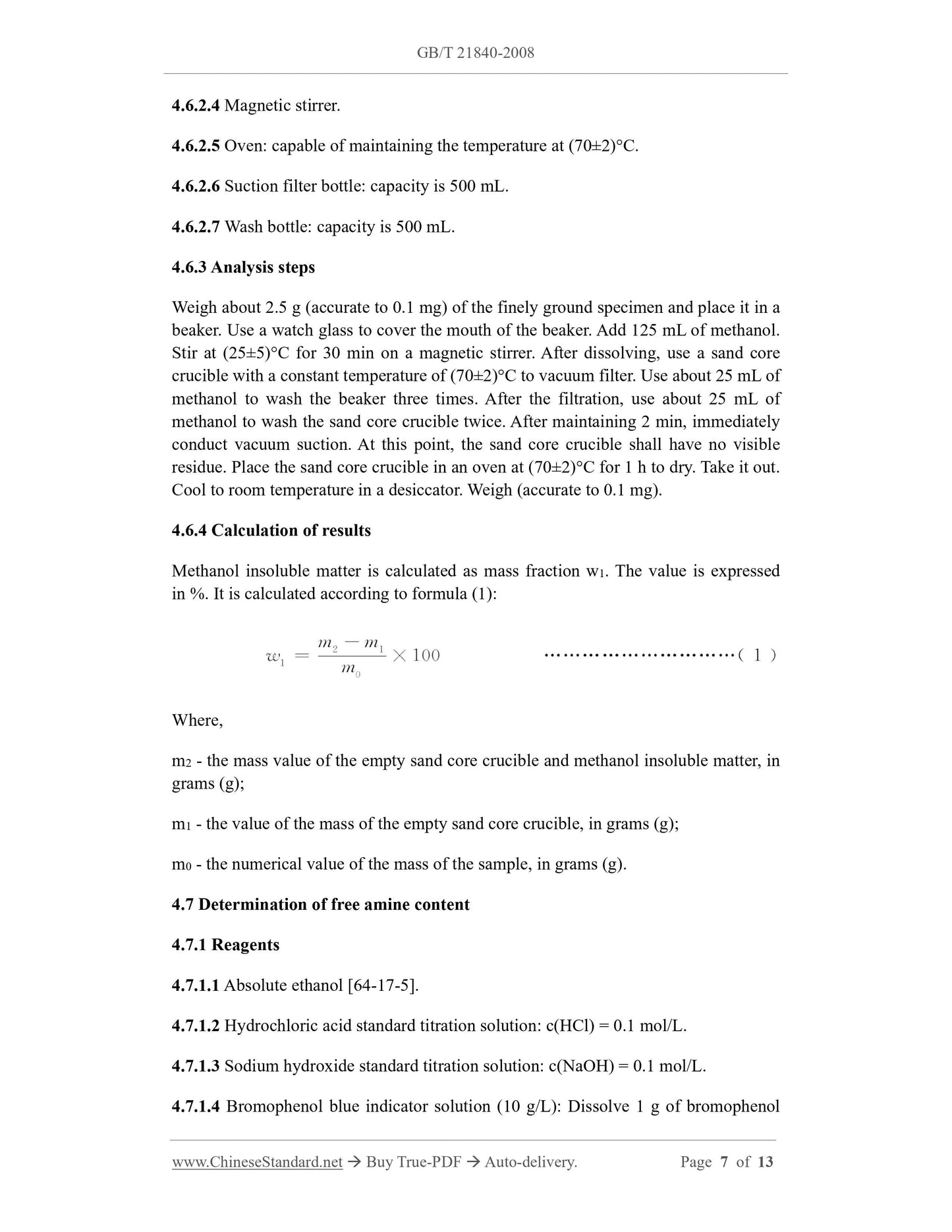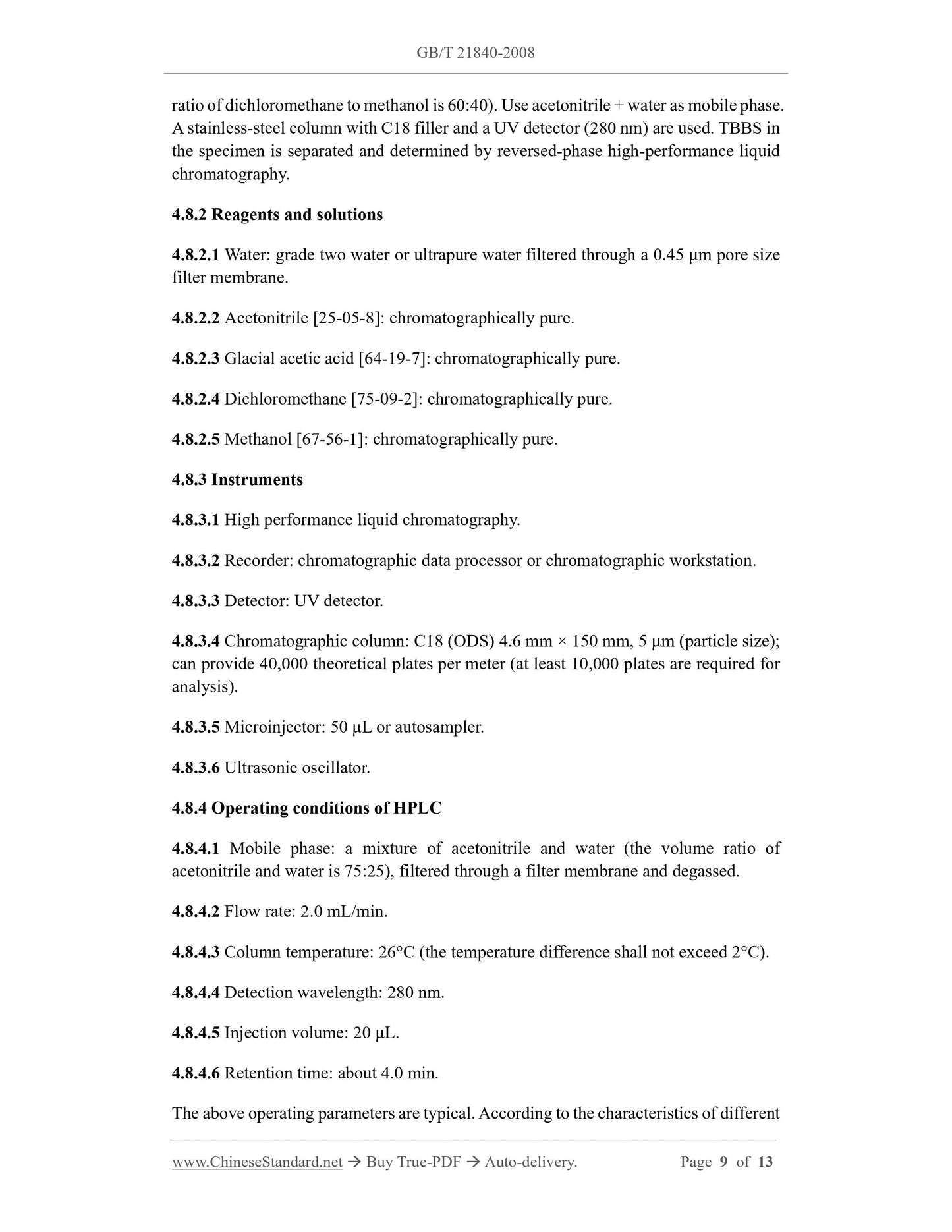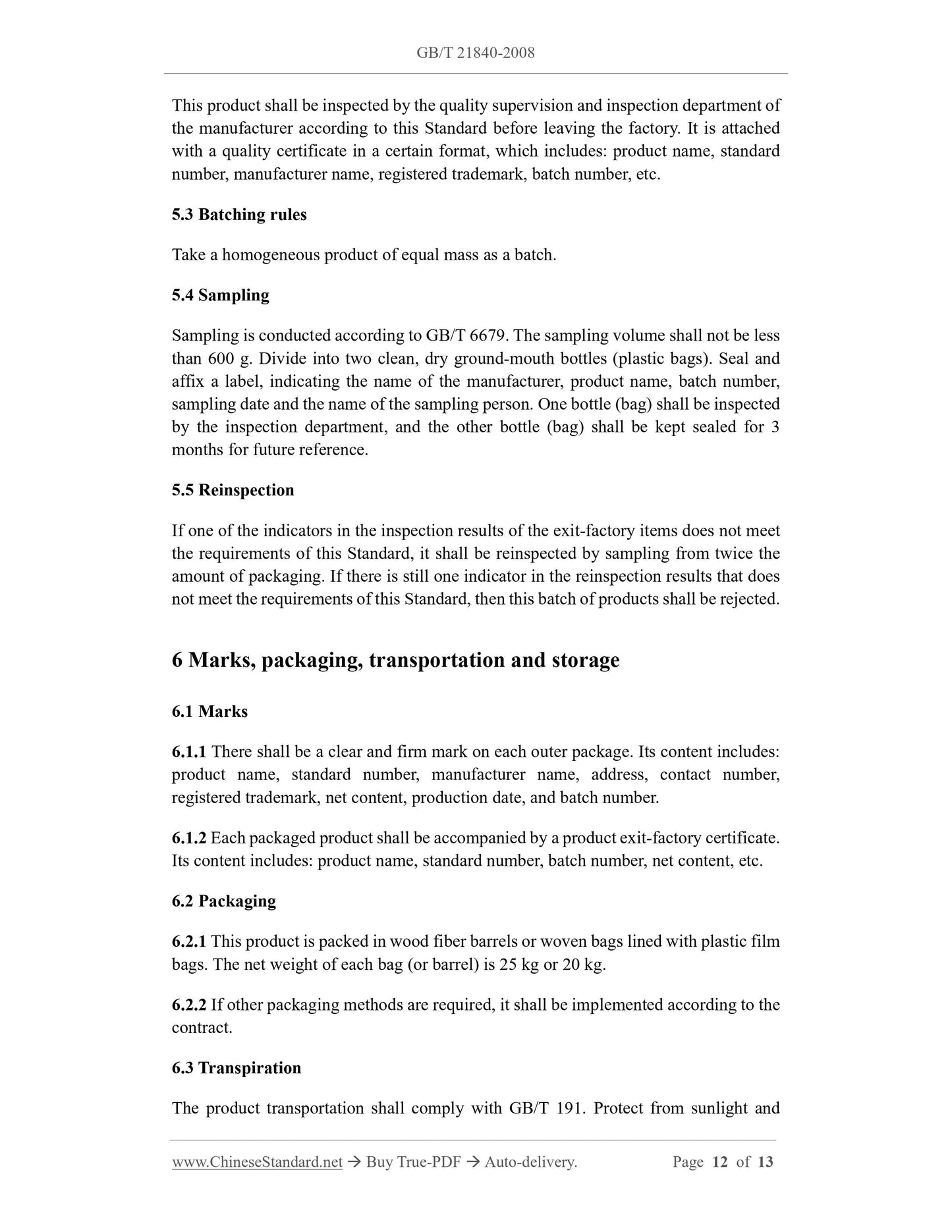1
/
of
7
www.ChineseStandard.us -- Field Test Asia Pte. Ltd.
GB/T 21840-2008 English PDF (GB/T21840-2008)
GB/T 21840-2008 English PDF (GB/T21840-2008)
Regular price
$130.00
Regular price
Sale price
$130.00
Unit price
/
per
Shipping calculated at checkout.
Couldn't load pickup availability
GB/T 21840-2008: Vulcanizing accelerator TBBS
Delivery: 9 seconds. Download (& Email) true-PDF + Invoice.
Get Quotation: Click GB/T 21840-2008 (Self-service in 1-minute)
Historical versions (Master-website): GB/T 21840-2008
Preview True-PDF (Reload/Scroll-down if blank)
GB/T 21840-2008
GB
NATIONAL STANDARD OF THE
PEOPLE’S REPUBLIC OF CHINA
ICS 83.040.20
G 71
Vulcanizing accelerator TBBS
硫化促进剂 TBBS
ISSUED ON: MAY 15, 2008
IMPLEMENTED ON: NOVEMBER 01, 2008
Issued by: General Administration of Quality Supervision, Inspection and
Quarantine of the People's Republic of China;
Standardization Administration of the People's Republic of China.
Table of Contents
Foreword ... 3
1 Scope ... 4
2 Normative references ... 4
3 Requirements ... 5
4 Test methods ... 5
5 Inspection rules ... 11
6 Marks, packaging, transportation and storage ... 12
Vulcanizing accelerator TBBS
1 Scope
This Standard specifies the requirements, test methods, inspection rules, marks,
packaging, transportation and storage for N-tert-butyl-2-benzothiazole sulfenamide
(vulcanizing accelerator TBBS).
This Standard is applicable to vulcanizing accelerator TBBS made by oxidation of tert-
butylamine and vulcanizing accelerator MBT.
Chemical name: N-tert-butyl-2-benzothiazole sulfenamide
Molecular formula: C11H14N2S2
Structural formula:
Relative molecular mass: 238.37 (according to the international relative atomic mass in
2005)
2 Normative references
The provisions in following documents become the provisions of this Standard through
reference in this Standard. For dated references, the subsequent amendments (excluding
corrigendum) or revisions do not apply to this Standard, however, parties who reach an
agreement based on this Standard are encouraged to study if the latest versions of these
documents are applicable. For undated references, the latest edition of the referenced
document applies.
GB/T 191, Packaging and storage marks (GB/T 191-2008, ISO 780:1997, MOD)
GB/T 601, Chemical reagent -- Preparations of reference titration solutions
GB/T 603, Chemical reagent -- Preparations of reagent solutions for use in test
methods (GB/T 603-2002, ISO 6353-1:1982, NEQ)
The judgment of the test results shall be carried out according to the rounded value
comparison method in GB/T 1250.
4.1 Appearance
Use visual inspection method to judge.
4.2 Determination of initial melting point
Carry out according to the provisions of GB/T 11409.1. The inner diameter of the
capillary containing the specimen is 1.2 mm ~ 1.4 mm. The thickness of the glass is 0.2
mm ~ 0.3 mm. Fill the sample 3mm ~ 6mm. When the temperature of the heat transfer
fluid is 25°C lower than the predicted melting point, heat up at a rate of 3°C/min. When
it rises to 10°C lower than the predicted melting point, attach the capillary containing
the sample to the thermometer. Make the center of the sample at the same height as the
middle of the mercury bulb of the thermometer. Insert into thermal fluid. Heat up at
(1±0.2)°C/min.
4.3 Determination of heating loss
Carry out according to the provisions of GB/T 11409.4. The sampling weight is about
2 g (accurate to 0.1 mg). The temperature of the electric constant temperature drying
oven is controlled at (70±2)°C. The heating time is 3 h.
4.4 Determination of ash
Carry out according to the provisions of GB/T 11409.7. The sampling weight is about
3 g (accurate to 0.1 mg). The temperature of the high temperature furnace is controlled
at (750±25)°C. Burning time is 2 h.
4.5 Determination of sieve residue
Determine according to the drying method in Chapter 2 of GB/T 11409.5-1989. Test
sieve (GB/T 6003.1): φ 200 mm × 50 mm / 150 μm.
4.6 Determination of methanol insoluble
4.6.1 Reagents
Methanol [67-56-1].
4.6.2 Instruments
4.6.2.1 Watch glass: 150 mm in diameter.
4.6.2.2 Beaker: 500 mL.
4.6.2.3 Sand core crucible: G4.
4.6.2.4 Magnetic stirrer.
4.6.2.5 Oven: capable of maintaining the temperature at (70±2)°C.
4.6.2.6 Suction filter bottle: capacity is 500 mL.
4.6.2.7 Wash bottle: capacity is 500 mL.
4.6.3 Analysis steps
Weigh about 2.5 g (accurate to 0.1 mg) of the finely ground specimen and place it in a
beaker. Use a watch glass to cover the mouth of the beaker. Add 125 mL of methanol.
Stir at (25±5)°C for 30 min on a magnetic stirrer. After dissolving, use a sand core
crucible with a constant temperature of (70±2)°C to vacuum filter. Use about 25 mL of
methanol to wash the beaker three times. After the filtration, use about 25 mL of
methanol to wash the sand core crucible twice. After maintaining 2 min, immediately
conduct vacuum suction. At this point, the sand core crucible shall have no visible
residue. Place the sand core crucible in an oven at (70±2)°C for 1 h to dry. Take it out.
Cool to room temperature in a desiccator. Weigh (accurate to 0.1 mg).
4.6.4 Calculation of results
Methanol insoluble matter is calculated as mass fraction w1. The value is expressed
in %. It is calculated according to formula (1):
Where,
m2 - the mass value of the empty sand core crucible and methanol insoluble matter, in
grams (g);
m1 - the value of the mass of the empty sand core crucible, in grams (g);
m0 - the numerical value of the mass of the sample, in grams (g).
4.7 Determination of free amine content
4.7.1 Reagents
4.7.1.1 Absolute ethanol [64-17-5].
4.7.1.2 Hydrochloric acid standard titration solution: c(HCl) = 0.1 mol/L.
4.7.1.3 Sodium hydroxide standard titration solution: c(NaOH) = 0.1 mol/L.
4.7.1.4 Bromophenol blue indicator solution (10 g/L): Dissolve 1 g of bromophenol
ratio of dichloromethane to methanol is 60:40). Use acetonitrile + water as mobile phase.
A stainless-steel column with C18 filler and a UV detector (280 nm) are used. TBBS in
the specimen is separated and determined by reversed-phase high-performance liquid
chromatography.
4.8.2 Reagents and solutions
4.8.2.1 Water: grade two water or ultrapure water filtered through a 0.45 μm pore size
filter membrane.
4.8.2.2 Acetonitrile [25-05-8]: chromatographically pure.
4.8.2.3 Glacial acetic acid [64-19-7]: chromatographically pure.
4.8.2.4 Dichloromethane [75-09-2]: chromatographically pure.
4.8.2.5 Methanol [67-56-1]: chromatographically pure.
4.8.3 Instruments
4.8.3.1 High performance liquid chromatography.
4.8.3.2 Recorder: chromatographic data processor or chromatographic workstation.
4.8.3.3 Detector: UV detector.
4.8.3.4 Chromatographic column: C18 (ODS) 4.6 mm × 150 mm, 5 μm (particle size);
can provide 40,000 theoretical plates per meter (at least 10,000 plates are required for
analysis).
4.8.3.5 Microinjector: 50 μL or autosampler.
4.8.3.6 Ultrasonic oscillator.
4.8.4 Operating conditions of HPLC
4.8.4.1 Mobile phase: a mixture of acetonitrile and water (the volume ratio of
acetonitrile and water is 75:25), filtered through a filter membrane and degassed.
4.8.4.2 Flow rate: 2.0 mL/min.
4.8.4.3 Column temperature: 26°C (the temperature difference shall not exceed 2°C).
4.8.4.4 Detection wavelength: 280 nm.
4.8.4.5 Injection volume: 20 μL.
4.8.4.6 Retention time: about 4.0 min.
The above operating parameters are typical. According to the characteristics of different
This product shall be inspected by the quality supervision and inspection department of
the manufacturer according to this Standard before leaving the factory. It is attached
with a quality certificate in a certain format, which includes: product name, standard
number, manufacturer name, registered trademark, batch number, etc.
5.3 Batching rules
Take a homogeneous product of equal mass as a batch.
5.4 Sampling
Sampling is conducted according to GB/T 6679. The sampling volume shall not be less
than 600 g. Divide into two clean, dry ground-mouth bottles (plastic bags). Seal and
affix a label, indicating the name of the manufacturer, product name, batch number,
sampling date and the name of the sampling person. One bottle (bag) shall be inspected
by the inspection department, and the other bottle (bag) shall be kept sealed for 3
months for future reference.
5.5 Reinspection
If one of the indicators in the inspection results of the exit-factory items does not meet
the requirements of this Standard, it shall be reinspected by sampling from twice the
amount of packaging. If there is still one indicator in the reinspection results that does
not meet the requirements of this Standard, then this batch of products shall be rejected.
6 Marks, packaging, transportation and storage
6.1 Marks
6.1.1 There shall be a clear and firm mark on each outer package. Its content includes:
product name, standard number, manufacturer name, address, contact number,
registered trademark, net content, production date, and batch number.
6.1.2 Each packaged product shall be accompanied by a product exit-factory certificate.
Its content includes: product name, standard number, batch number, net content, etc.
6.2 Packaging
6.2.1 This product is packed in wood fiber barrels or woven bags lined with plastic film
bags. The net weight of each bag (or barrel) is 25 kg or 20 kg.
6.2.2 If other packaging methods are required, it shall be implemented according to the
contract.
6.3 Transpiration
The product transportation shall comply with GB/T 191. Protect from sunlight and
GB/T 21840-2008
GB
NATIONAL STANDARD OF THE
PEOPLE’S REPUBLIC OF CHINA
ICS 83.040.20
G 71
Vulcanizing accelerator TBBS
硫化促进剂 TBBS
ISSUED ON: MAY 15, 2008
IMPLEMENTED ON: NOVEMBER 01, 2008
Issued by: General Administration of Quality Supervision, Inspection and
Quarantine of the People's Republic of China;
Standardization Administration of the People's Republic of China.
Table of Contents
Foreword ... 3
1 Scope ... 4
2 Normative references ... 4
3 Requirements ... 5
4 Test methods ... 5
5 Inspection rules ... 11
6 Marks, packaging, transportation and storage ... 12
Vulcanizing accelerator TBBS
1 Scope
This Standard specifies the requirements, test methods, inspection rules, marks,
packaging, transportation and storage for N-tert-butyl-2-benzothiazole sulfenamide
(vulcanizing accelerator TBBS).
This Standard is applicable to vulcanizing accelerator TBBS made by oxidation of tert-
butylamine and vulcanizing accelerator MBT.
Chemical name: N-tert-butyl-2-benzothiazole sulfenamide
Molecular formula: C11H14N2S2
Structural formula:
Relative molecular mass: 238.37 (according to the international relative atomic mass in
2005)
2 Normative references
The provisions in following documents become the provisions of this Standard through
reference in this Standard. For dated references, the subsequent amendments (excluding
corrigendum) or revisions do not apply to this Standard, however, parties who reach an
agreement based on this Standard are encouraged to study if the latest versions of these
documents are applicable. For undated references, the latest edition of the referenced
document applies.
GB/T 191, Packaging and storage marks (GB/T 191-2008, ISO 780:1997, MOD)
GB/T 601, Chemical reagent -- Preparations of reference titration solutions
GB/T 603, Chemical reagent -- Preparations of reagent solutions for use in test
methods (GB/T 603-2002, ISO 6353-1:1982, NEQ)
The judgment of the test results shall be carried out according to the rounded value
comparison method in GB/T 1250.
4.1 Appearance
Use visual inspection method to judge.
4.2 Determination of initial melting point
Carry out according to the provisions of GB/T 11409.1. The inner diameter of the
capillary containing the specimen is 1.2 mm ~ 1.4 mm. The thickness of the glass is 0.2
mm ~ 0.3 mm. Fill the sample 3mm ~ 6mm. When the temperature of the heat transfer
fluid is 25°C lower than the predicted melting point, heat up at a rate of 3°C/min. When
it rises to 10°C lower than the predicted melting point, attach the capillary containing
the sample to the thermometer. Make the center of the sample at the same height as the
middle of the mercury bulb of the thermometer. Insert into thermal fluid. Heat up at
(1±0.2)°C/min.
4.3 Determination of heating loss
Carry out according to the provisions of GB/T 11409.4. The sampling weight is about
2 g (accurate to 0.1 mg). The temperature of the electric constant temperature drying
oven is controlled at (70±2)°C. The heating time is 3 h.
4.4 Determination of ash
Carry out according to the provisions of GB/T 11409.7. The sampling weight is about
3 g (accurate to 0.1 mg). The temperature of the high temperature furnace is controlled
at (750±25)°C. Burning time is 2 h.
4.5 Determination of sieve residue
Determine according to the drying method in Chapter 2 of GB/T 11409.5-1989. Test
sieve (GB/T 6003.1): φ 200 mm × 50 mm / 150 μm.
4.6 Determination of methanol insoluble
4.6.1 Reagents
Methanol [67-56-1].
4.6.2 Instruments
4.6.2.1 Watch glass: 150 mm in diameter.
4.6.2.2 Beaker: 500 mL.
4.6.2.3 Sand core crucible: G4.
4.6.2.4 Magnetic stirrer.
4.6.2.5 Oven: capable of maintaining the temperature at (70±2)°C.
4.6.2.6 Suction filter bottle: capacity is 500 mL.
4.6.2.7 Wash bottle: capacity is 500 mL.
4.6.3 Analysis steps
Weigh about 2.5 g (accurate to 0.1 mg) of the finely ground specimen and place it in a
beaker. Use a watch glass to cover the mouth of the beaker. Add 125 mL of methanol.
Stir at (25±5)°C for 30 min on a magnetic stirrer. After dissolving, use a sand core
crucible with a constant temperature of (70±2)°C to vacuum filter. Use about 25 mL of
methanol to wash the beaker three times. After the filtration, use about 25 mL of
methanol to wash the sand core crucible twice. After maintaining 2 min, immediately
conduct vacuum suction. At this point, the sand core crucible shall have no visible
residue. Place the sand core crucible in an oven at (70±2)°C for 1 h to dry. Take it out.
Cool to room temperature in a desiccator. Weigh (accurate to 0.1 mg).
4.6.4 Calculation of results
Methanol insoluble matter is calculated as mass fraction w1. The value is expressed
in %. It is calculated according to formula (1):
Where,
m2 - the mass value of the empty sand core crucible and methanol insoluble matter, in
grams (g);
m1 -...
Delivery: 9 seconds. Download (& Email) true-PDF + Invoice.
Get Quotation: Click GB/T 21840-2008 (Self-service in 1-minute)
Historical versions (Master-website): GB/T 21840-2008
Preview True-PDF (Reload/Scroll-down if blank)
GB/T 21840-2008
GB
NATIONAL STANDARD OF THE
PEOPLE’S REPUBLIC OF CHINA
ICS 83.040.20
G 71
Vulcanizing accelerator TBBS
硫化促进剂 TBBS
ISSUED ON: MAY 15, 2008
IMPLEMENTED ON: NOVEMBER 01, 2008
Issued by: General Administration of Quality Supervision, Inspection and
Quarantine of the People's Republic of China;
Standardization Administration of the People's Republic of China.
Table of Contents
Foreword ... 3
1 Scope ... 4
2 Normative references ... 4
3 Requirements ... 5
4 Test methods ... 5
5 Inspection rules ... 11
6 Marks, packaging, transportation and storage ... 12
Vulcanizing accelerator TBBS
1 Scope
This Standard specifies the requirements, test methods, inspection rules, marks,
packaging, transportation and storage for N-tert-butyl-2-benzothiazole sulfenamide
(vulcanizing accelerator TBBS).
This Standard is applicable to vulcanizing accelerator TBBS made by oxidation of tert-
butylamine and vulcanizing accelerator MBT.
Chemical name: N-tert-butyl-2-benzothiazole sulfenamide
Molecular formula: C11H14N2S2
Structural formula:
Relative molecular mass: 238.37 (according to the international relative atomic mass in
2005)
2 Normative references
The provisions in following documents become the provisions of this Standard through
reference in this Standard. For dated references, the subsequent amendments (excluding
corrigendum) or revisions do not apply to this Standard, however, parties who reach an
agreement based on this Standard are encouraged to study if the latest versions of these
documents are applicable. For undated references, the latest edition of the referenced
document applies.
GB/T 191, Packaging and storage marks (GB/T 191-2008, ISO 780:1997, MOD)
GB/T 601, Chemical reagent -- Preparations of reference titration solutions
GB/T 603, Chemical reagent -- Preparations of reagent solutions for use in test
methods (GB/T 603-2002, ISO 6353-1:1982, NEQ)
The judgment of the test results shall be carried out according to the rounded value
comparison method in GB/T 1250.
4.1 Appearance
Use visual inspection method to judge.
4.2 Determination of initial melting point
Carry out according to the provisions of GB/T 11409.1. The inner diameter of the
capillary containing the specimen is 1.2 mm ~ 1.4 mm. The thickness of the glass is 0.2
mm ~ 0.3 mm. Fill the sample 3mm ~ 6mm. When the temperature of the heat transfer
fluid is 25°C lower than the predicted melting point, heat up at a rate of 3°C/min. When
it rises to 10°C lower than the predicted melting point, attach the capillary containing
the sample to the thermometer. Make the center of the sample at the same height as the
middle of the mercury bulb of the thermometer. Insert into thermal fluid. Heat up at
(1±0.2)°C/min.
4.3 Determination of heating loss
Carry out according to the provisions of GB/T 11409.4. The sampling weight is about
2 g (accurate to 0.1 mg). The temperature of the electric constant temperature drying
oven is controlled at (70±2)°C. The heating time is 3 h.
4.4 Determination of ash
Carry out according to the provisions of GB/T 11409.7. The sampling weight is about
3 g (accurate to 0.1 mg). The temperature of the high temperature furnace is controlled
at (750±25)°C. Burning time is 2 h.
4.5 Determination of sieve residue
Determine according to the drying method in Chapter 2 of GB/T 11409.5-1989. Test
sieve (GB/T 6003.1): φ 200 mm × 50 mm / 150 μm.
4.6 Determination of methanol insoluble
4.6.1 Reagents
Methanol [67-56-1].
4.6.2 Instruments
4.6.2.1 Watch glass: 150 mm in diameter.
4.6.2.2 Beaker: 500 mL.
4.6.2.3 Sand core crucible: G4.
4.6.2.4 Magnetic stirrer.
4.6.2.5 Oven: capable of maintaining the temperature at (70±2)°C.
4.6.2.6 Suction filter bottle: capacity is 500 mL.
4.6.2.7 Wash bottle: capacity is 500 mL.
4.6.3 Analysis steps
Weigh about 2.5 g (accurate to 0.1 mg) of the finely ground specimen and place it in a
beaker. Use a watch glass to cover the mouth of the beaker. Add 125 mL of methanol.
Stir at (25±5)°C for 30 min on a magnetic stirrer. After dissolving, use a sand core
crucible with a constant temperature of (70±2)°C to vacuum filter. Use about 25 mL of
methanol to wash the beaker three times. After the filtration, use about 25 mL of
methanol to wash the sand core crucible twice. After maintaining 2 min, immediately
conduct vacuum suction. At this point, the sand core crucible shall have no visible
residue. Place the sand core crucible in an oven at (70±2)°C for 1 h to dry. Take it out.
Cool to room temperature in a desiccator. Weigh (accurate to 0.1 mg).
4.6.4 Calculation of results
Methanol insoluble matter is calculated as mass fraction w1. The value is expressed
in %. It is calculated according to formula (1):
Where,
m2 - the mass value of the empty sand core crucible and methanol insoluble matter, in
grams (g);
m1 - the value of the mass of the empty sand core crucible, in grams (g);
m0 - the numerical value of the mass of the sample, in grams (g).
4.7 Determination of free amine content
4.7.1 Reagents
4.7.1.1 Absolute ethanol [64-17-5].
4.7.1.2 Hydrochloric acid standard titration solution: c(HCl) = 0.1 mol/L.
4.7.1.3 Sodium hydroxide standard titration solution: c(NaOH) = 0.1 mol/L.
4.7.1.4 Bromophenol blue indicator solution (10 g/L): Dissolve 1 g of bromophenol
ratio of dichloromethane to methanol is 60:40). Use acetonitrile + water as mobile phase.
A stainless-steel column with C18 filler and a UV detector (280 nm) are used. TBBS in
the specimen is separated and determined by reversed-phase high-performance liquid
chromatography.
4.8.2 Reagents and solutions
4.8.2.1 Water: grade two water or ultrapure water filtered through a 0.45 μm pore size
filter membrane.
4.8.2.2 Acetonitrile [25-05-8]: chromatographically pure.
4.8.2.3 Glacial acetic acid [64-19-7]: chromatographically pure.
4.8.2.4 Dichloromethane [75-09-2]: chromatographically pure.
4.8.2.5 Methanol [67-56-1]: chromatographically pure.
4.8.3 Instruments
4.8.3.1 High performance liquid chromatography.
4.8.3.2 Recorder: chromatographic data processor or chromatographic workstation.
4.8.3.3 Detector: UV detector.
4.8.3.4 Chromatographic column: C18 (ODS) 4.6 mm × 150 mm, 5 μm (particle size);
can provide 40,000 theoretical plates per meter (at least 10,000 plates are required for
analysis).
4.8.3.5 Microinjector: 50 μL or autosampler.
4.8.3.6 Ultrasonic oscillator.
4.8.4 Operating conditions of HPLC
4.8.4.1 Mobile phase: a mixture of acetonitrile and water (the volume ratio of
acetonitrile and water is 75:25), filtered through a filter membrane and degassed.
4.8.4.2 Flow rate: 2.0 mL/min.
4.8.4.3 Column temperature: 26°C (the temperature difference shall not exceed 2°C).
4.8.4.4 Detection wavelength: 280 nm.
4.8.4.5 Injection volume: 20 μL.
4.8.4.6 Retention time: about 4.0 min.
The above operating parameters are typical. According to the characteristics of different
This product shall be inspected by the quality supervision and inspection department of
the manufacturer according to this Standard before leaving the factory. It is attached
with a quality certificate in a certain format, which includes: product name, standard
number, manufacturer name, registered trademark, batch number, etc.
5.3 Batching rules
Take a homogeneous product of equal mass as a batch.
5.4 Sampling
Sampling is conducted according to GB/T 6679. The sampling volume shall not be less
than 600 g. Divide into two clean, dry ground-mouth bottles (plastic bags). Seal and
affix a label, indicating the name of the manufacturer, product name, batch number,
sampling date and the name of the sampling person. One bottle (bag) shall be inspected
by the inspection department, and the other bottle (bag) shall be kept sealed for 3
months for future reference.
5.5 Reinspection
If one of the indicators in the inspection results of the exit-factory items does not meet
the requirements of this Standard, it shall be reinspected by sampling from twice the
amount of packaging. If there is still one indicator in the reinspection results that does
not meet the requirements of this Standard, then this batch of products shall be rejected.
6 Marks, packaging, transportation and storage
6.1 Marks
6.1.1 There shall be a clear and firm mark on each outer package. Its content includes:
product name, standard number, manufacturer name, address, contact number,
registered trademark, net content, production date, and batch number.
6.1.2 Each packaged product shall be accompanied by a product exit-factory certificate.
Its content includes: product name, standard number, batch number, net content, etc.
6.2 Packaging
6.2.1 This product is packed in wood fiber barrels or woven bags lined with plastic film
bags. The net weight of each bag (or barrel) is 25 kg or 20 kg.
6.2.2 If other packaging methods are required, it shall be implemented according to the
contract.
6.3 Transpiration
The product transportation shall comply with GB/T 191. Protect from sunlight and
GB/T 21840-2008
GB
NATIONAL STANDARD OF THE
PEOPLE’S REPUBLIC OF CHINA
ICS 83.040.20
G 71
Vulcanizing accelerator TBBS
硫化促进剂 TBBS
ISSUED ON: MAY 15, 2008
IMPLEMENTED ON: NOVEMBER 01, 2008
Issued by: General Administration of Quality Supervision, Inspection and
Quarantine of the People's Republic of China;
Standardization Administration of the People's Republic of China.
Table of Contents
Foreword ... 3
1 Scope ... 4
2 Normative references ... 4
3 Requirements ... 5
4 Test methods ... 5
5 Inspection rules ... 11
6 Marks, packaging, transportation and storage ... 12
Vulcanizing accelerator TBBS
1 Scope
This Standard specifies the requirements, test methods, inspection rules, marks,
packaging, transportation and storage for N-tert-butyl-2-benzothiazole sulfenamide
(vulcanizing accelerator TBBS).
This Standard is applicable to vulcanizing accelerator TBBS made by oxidation of tert-
butylamine and vulcanizing accelerator MBT.
Chemical name: N-tert-butyl-2-benzothiazole sulfenamide
Molecular formula: C11H14N2S2
Structural formula:
Relative molecular mass: 238.37 (according to the international relative atomic mass in
2005)
2 Normative references
The provisions in following documents become the provisions of this Standard through
reference in this Standard. For dated references, the subsequent amendments (excluding
corrigendum) or revisions do not apply to this Standard, however, parties who reach an
agreement based on this Standard are encouraged to study if the latest versions of these
documents are applicable. For undated references, the latest edition of the referenced
document applies.
GB/T 191, Packaging and storage marks (GB/T 191-2008, ISO 780:1997, MOD)
GB/T 601, Chemical reagent -- Preparations of reference titration solutions
GB/T 603, Chemical reagent -- Preparations of reagent solutions for use in test
methods (GB/T 603-2002, ISO 6353-1:1982, NEQ)
The judgment of the test results shall be carried out according to the rounded value
comparison method in GB/T 1250.
4.1 Appearance
Use visual inspection method to judge.
4.2 Determination of initial melting point
Carry out according to the provisions of GB/T 11409.1. The inner diameter of the
capillary containing the specimen is 1.2 mm ~ 1.4 mm. The thickness of the glass is 0.2
mm ~ 0.3 mm. Fill the sample 3mm ~ 6mm. When the temperature of the heat transfer
fluid is 25°C lower than the predicted melting point, heat up at a rate of 3°C/min. When
it rises to 10°C lower than the predicted melting point, attach the capillary containing
the sample to the thermometer. Make the center of the sample at the same height as the
middle of the mercury bulb of the thermometer. Insert into thermal fluid. Heat up at
(1±0.2)°C/min.
4.3 Determination of heating loss
Carry out according to the provisions of GB/T 11409.4. The sampling weight is about
2 g (accurate to 0.1 mg). The temperature of the electric constant temperature drying
oven is controlled at (70±2)°C. The heating time is 3 h.
4.4 Determination of ash
Carry out according to the provisions of GB/T 11409.7. The sampling weight is about
3 g (accurate to 0.1 mg). The temperature of the high temperature furnace is controlled
at (750±25)°C. Burning time is 2 h.
4.5 Determination of sieve residue
Determine according to the drying method in Chapter 2 of GB/T 11409.5-1989. Test
sieve (GB/T 6003.1): φ 200 mm × 50 mm / 150 μm.
4.6 Determination of methanol insoluble
4.6.1 Reagents
Methanol [67-56-1].
4.6.2 Instruments
4.6.2.1 Watch glass: 150 mm in diameter.
4.6.2.2 Beaker: 500 mL.
4.6.2.3 Sand core crucible: G4.
4.6.2.4 Magnetic stirrer.
4.6.2.5 Oven: capable of maintaining the temperature at (70±2)°C.
4.6.2.6 Suction filter bottle: capacity is 500 mL.
4.6.2.7 Wash bottle: capacity is 500 mL.
4.6.3 Analysis steps
Weigh about 2.5 g (accurate to 0.1 mg) of the finely ground specimen and place it in a
beaker. Use a watch glass to cover the mouth of the beaker. Add 125 mL of methanol.
Stir at (25±5)°C for 30 min on a magnetic stirrer. After dissolving, use a sand core
crucible with a constant temperature of (70±2)°C to vacuum filter. Use about 25 mL of
methanol to wash the beaker three times. After the filtration, use about 25 mL of
methanol to wash the sand core crucible twice. After maintaining 2 min, immediately
conduct vacuum suction. At this point, the sand core crucible shall have no visible
residue. Place the sand core crucible in an oven at (70±2)°C for 1 h to dry. Take it out.
Cool to room temperature in a desiccator. Weigh (accurate to 0.1 mg).
4.6.4 Calculation of results
Methanol insoluble matter is calculated as mass fraction w1. The value is expressed
in %. It is calculated according to formula (1):
Where,
m2 - the mass value of the empty sand core crucible and methanol insoluble matter, in
grams (g);
m1 -...
Share
